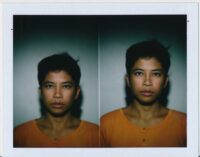
Q&A – Emmanuelle Andrianjafy
9.6.20
Emmanuelle Andrianjafy lives and works in Dakar, Senegal. Her project Nothing’s in Vain was the winner of the MACK First Book Award and Contemporary African Photography Prize in 2017, and was a finalist in the Aperture Portfolio Prize in the same year. She is currently working on a new body of work in which she returns to her native Madagascar to explore notions of belonging and identity in relation to her family and memory. Here she shares her experience of coming late to photography and confronting the city with her camera. Look out for her work at PHOTO 2021 in partnership with Metro Tunnel Creative Program.
What started your relationship with photography?
I grew up with no exposure to art. I graduated and worked as an electrical engineer for several years. I am from Madagascar, lived a few years in France and in 2011 I moved to Senegal. I felt overwhelmed by my new environment and in 2013 started taking pictures of Dakar, the capital, as a way to deal with it. That’s how my relationship with photography began. This resulted in a photobook, Nothing’s in Vain, published in 2017. I had never imagined becoming a photographer/artist. It simply happened.
What is your motivation for making art? How has your practice changed over time?
I would say my practice is quite recent. The project I am currently working on is again inspired by my personal story: it addresses my relationship to my native country Madagascar. Although the subjects are different, the process is similar to Nothing’s in Vain’s which consists in photographing intuitively in a given environment. So, I don’t think my practice has changed, at least for now. I am motivated by processing my story through photography.
How do ideas relating to 'The Truth’ factor into your practice?
My projects are “my truth”.
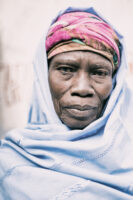
From the series Nothing’s in Vain, 2017

From the series Nothing’s in Vain, 2017
In this post-internet age, how do you see the viewer in relation to your artwork?
I don’t think about the viewer when I am photographing nor when my projects are finished. I do appreciate that there may be viewers, but it’s never really on my mind. I also keep in mind we view and interpret work in our own ways, and I accept that. I am happy to be able to share my perspective.
How do you go about developing / planning for new projects?
My projects are inspired by my lived experience. Nothing’s in Vain is my response to the experience of uprooting to Dakar and trying to make sense of the city. In my second project, I return to my native Madagascar. They are very different in subject, but the way I go about developing them is the same, intuitive. I need to be in the environment I’m inspired by, photographing then comes naturally. I try to maintain a discipline of photographing as much as possible. I will certain days be focusing on photographing only in one place, or only the streets, or only objects, etc. Time then plays an important part, organizing the images and especially time needed to get familiar with them and editing. When I started photographing Dakar, I wasn’t thinking about the form the project would take. For me, it was just about confronting the city with my camera. With time, it made sense to make a photobook.
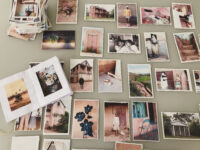
Emmanuelle getting familiar with her images from Madagascar
How does your lived experience influence your work?
Everything stems from my lived experience.
Who or what inspires you?
I am inspired by the observation of my environment though not all speak to me. I have lived several years in Paris and have never felt the need to photograph. In Dakar, I was overwhelmed by the urban landscape, the city’s energy, and the semi-arid conditions amongst other things. In Madagascar, I have all my childhood memories and family. I guess it is the emotions and questions raised by an environment that inspire me.
What books are you currently reading?
Sapiens: A Brief History of Humankind by Yuva Noah Harari
Brief Answers to the Big Questions by Stephen Hawking
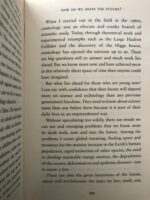
From the book, Brief Answers to the Big Questions
What is your favourite website?
I enjoy Formula1.com. A lot of the focus is on the pilots, but it is as much about science and engineering from the car construction to how the races unfold. I like how every element is intricately connected to gain tenths of seconds. The win is in the details and teamwork. Formula 1 season is currently suspended so I do spend quite some time reading their articles and listening to interviews on their website.
What music are you listening to?
In March I was in Madagascar, where all my family is, working on my new project. On 15 March, the president announced that the country was suspending incoming and outcoming international flights. It was a matter of hours or days for Senegal and other countries to do the same. I urgently flew back to Senegal the next day so my husband and I could be together. It was a strange trip back, leaving home to go back home. I randomly picked a playlist to listen to in the plane, on repeat. Some of this music reminds me of my trip to Madagascar and I keep listening to them: “I’m Not Running Away” (Feist), “ILYSB” (LANY), “The Only Reason” (JP Cooper), “Be Alright” (Dean Lewis), “Slow Up” (Jacob Banks). Right before going to Madagascar, I was listening to “Ilay Nosy” (Mahaleo), a Malagasy song about homeland, and it’s playing again now.
If the work you are presenting at PHOTO 2021 was a song, what would it be?
The title of my photobook is also the title of an album by Senegalese artist, Youssou N’dour. I would choose his album, Nothing’s in Vain.
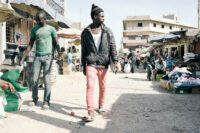
From the series Nothing’s in Vain, 2017
How are you spending your time with the current social distancing restrictions? Has this motivated you in a way that you might not have expected? Are you working on something new?
Among other measures, Senegal has imposed a dusk-to-dawn curfew, the closing of schools and universities, and banned public gatherings. But Dakar is not on lockdown. The city has of course slowed down and people have limited their movements. In the context of countries like Senegal and Madagascar, it is a privilege to be able to stay home. I feel grateful to be able to do so and to think my parents and brother are home too. My days are split between walking the dog, working out, cleaning, watering the grass, spending some time with my husband and getting familiar with my images taken in Madagascar.
How do you hope our creative community will overcome this unique challenge?
I guess we will overcome this challenge like any other community, by respecting measures (hopefully guided by science and facts) taken by our governments, helping each other out and being patient.
Do you have any daily rituals?
I don’t have any rituals, but I need to release my energy daily. I do that by working out. Walking the dog helps to disconnect. It’s a routine I’ve followed for years.
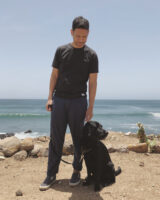
Walking the dog
What advice would you give to your 15-year-old self?
I don’t think I have any advice to give my 15-year-old self. I have always pursued what I wanted so I probably would still tell myself to do what I want.